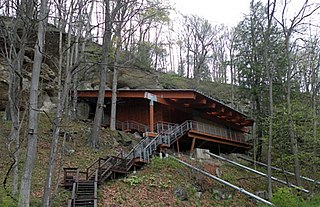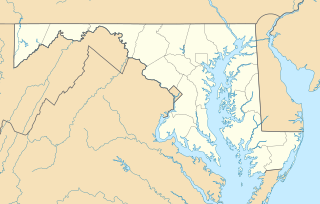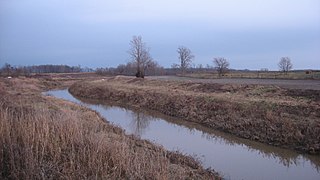 W
WLake Abert is a large, shallow, alkali lake in Lake County, Oregon, United States. It is approximately 15 miles (24 km) long and 7 miles (11 km) wide at its widest point. It is located 3 miles (4.8 km) northeast of the small, unincorporated community of Valley Falls, Oregon. The lake was named in honor of Colonel John James Abert by explorer John C. Fremont during his 1843 expedition into Central Oregon. No fish live in the alkaline waters of the lake; however, its dense population of brine shrimp supports a variety of shorebirds. The lake is also an important stop on the bird migration route known as the Pacific flyway.
 W
WThe Adams County Paleo-Indian District is an archaeological site near Sandy Springs in Green Township, Adams County, Ohio, United States.
 W
WThe Burning Tree Mastodon site in Heath, southern Licking County, Ohio, represents the location where the most complete skeleton of American mastodon was found. It is dated to about 11,500 BP. It is believed that there was human presence at the site at that time.
Buttermilk Creek Complex refers to the remains of a paleolithic settlement along the shores of Buttermilk Creek in present-day Salado, Texas dated to approximately 15,500 years old. If confirmed, the site represents evidence of human settlement in the Americas that pre-dates the Clovis culture.
 W
WThe Calico Early Man Site is an archaeological site in an ancient Pleistocene lake located near Barstow in San Bernardino County in the central Mojave Desert of southern California. This site is on and in late middle-Pleistocene fanglomerates known variously as the Calico Hills, the Yermo Hills, or the Yermo formation. Holocene evidence includes petroglyphs and trail segments that are probably related to outcrops of local high-quality siliceous rock.
 W
WThe Cary Village Site is an archaeological site in the west-central portion of the U.S. state of Ohio. Located southeast of the village of Plain City in Madison County, the site occupies a group of grassy terraces located amid two farm fields. In this grassy area, archaeologists have discovered a wide range of artifacts, including stone tools, materials made of flint, and various types of pottery.
 W
WThe Gault archaeological site is an extensive, multicomponent site located in central Texas, United States, about 40 miles (64 km) north of Austin. It bears evidence of almost continuous human occupation, starting at least 16,000 years ago—making it one of the few archaeological sites in the Americas at which compelling evidence has been found for human occupation dating to before the appearance of the Clovis culture.
 W
WHell Gap is a deeply stratified archaeological site located in the Great Plains of eastern Wyoming, approximately thirteen miles north of Guernsey, where an abundant amount of Paleoindian and Archaic artifacts have been found and excavated since 1959. This site has had an important impact on North American archaeology because of the large quantity and breadth of prehistoric Paleoindian and Archaic period artifacts and cultures it encompasses. It was designated a National Historic Landmark in 2016.
 W
WThe Hiscock Site is an archaeological and paleobiological site in Byron, Western New York, United States that has yielded many mastodon and paleo-Indian artifacts, as well as the remains of flora and fauna not previously known to have inhabited Western New York during the late Pleistocene. Now owned by the Buffalo Museum of Science, it has been studied by archeological excavation and analysis since 1983.
 W
WLeonard Rockshelter, designated 26PE14, is a prehistoric site in the U.S. state of Nevada that was discovered in 1936. It was declared a National Historic Landmark in 1961, qualifying because its well-preserved stratigraphy revealed a long continuum of sporadic cultural occupations from 6710 BC to AD 1400. The site was named after Zenas Leonard, a member of the Bonneville-Walker expedition which passed through the Humboldt Valley in 1833. It was added to the National Register of Historic Places in 1966.
 W
WThe Lind Coulee Archaeological Site, also known as 45GR97, is the site of an archaeological dig near Warden, Washington. It dates to c. 11,000 cal BP.
 W
WMeadowcroft Rockshelter is an archaeological site located near Avella in Jefferson Township, Washington County, Pennsylvania, United States. The site is a rock shelter in a bluff overlooking Cross Creek, and contains evidence that the area may have been continually inhabited for more than 19,000 years. If accurately dated, the site would be the earliest known evidence of human presence and the longest sequence of continuous human occupation in the New World.
 W
WNenana Valley is an archaeological site in the Yukon-Koyukuk Census Area of Alaska.
 W
WNolands Ferry I Archeological Site is an archaeological site near Tuscarora. It is a prehistoric occupation site located in the Monocacy region of southern Frederick County, Maryland. Diagnostic artifacts at the site indicate that the site was almost continuously inhabited from the Paleo-Indian period to the early 19th century, with the most substantial inhabitation occurring during the Late Woodland period.
 W
WThe Potts Creek Rockshelter Archeological Site, within Hoosier National Forest in Crawford County, Indiana, was a camp for Archaic, Woodland, and Paleo-Indian Indians. It is currently unoccupied by habitation.
 W
WThe Prairie Creek Site is an archaeological site in the southwestern part of the U.S. state of Indiana. Located approximately 3 miles (4.8 km) north of Washington in Daviess County, it lies along the southern bank of the westward-flowing Prairie Creek, a White River tributary. About 1 mile (1.6 km) to the east of the site, the stream leaves the Thousand Acre Woods, a heavily wooded area around a glacial lake; six miles downstream is the creek's confluence with the White River.